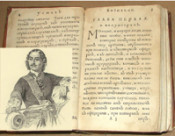
Peter I approved the “Land forces regulations”
30 March (10 April) 1716 Peter I approved the “Land forces regulations”, a legal document which legalized the establishment of regular army in Russia and defined the order of its life and activity.
Regulation of military affairs is known in Russia since the 16-17th centuries. For example, in 1647 was issued a document titled "Doctrine and cunning of military order of infantry men of Muscovy”, which was a simple translation from the German analog and consisted mainly of combatant manuals of “late formation of imperial troops. The Regulations of 1716 were fundamentally different by content. The docment reflected the results of military reforms of Peter I in the area of organization, staffing, training troops, as well as changes in methods of warfare based on the experience of the Northern War (1700-1721). Peter had been working on the Regulations for several years, comprehensively and deeply studying foreign experience.
Land forces regulations of Peter I included three parts. The first one reflected the structure of troops’ organization. The Regulations provided for a light corps ("korvolant"), as well as a reserve corps. Special chapters were devoted to general (field) Staff, Quartermaster service, field service, camp structure, guards, holding parades, organization of field hospitals, post offices, etc. Especially were mentioned the rights and obligations of higher military ranks.
The second part of the Regulations was called the "Military Model". It contained information on federal, state and criminal law, structure of military courts and procedure for cases consideration, as well as provisions relating to military discipline and internal services. The Regulations introduced a military oath, and defined the order of its taking.
The third part of the Regulation - "On exercises" – covered to service in the ranks, military training and education, rights and duties of the regimental ranks. Particular attention was paid to the spurring of initiatives among the officers and soldiers in combat, raising their high patriotism, military honor and courage.
“Land forces regulations” of 1716 by the wealth of its content was significantly superior to all the ordinances of Western European armies and exerted significant influence on the development of the Russian criminal law. Its provisions remained in effect without any special changes until the end of 19th century.
Lit.: Артикул воинский 1715 г. // Российское законодательство X–XX вв. Т. 4. Законодательство периода становления абсолютизма. М., 1986; То же [Электронный ресурс]. URL: http://militera.lib.ru/regulations/russr/1715_artikul/index.html; Бескровный Л. Г. Русская армия и флот в XVIII веке. М., 1958; Бобровский П. Р. Военное право в России при Петре Великом. Артикул Воинский. Вып. 1—2. СПб., 1882—1886; Бобровский П. Р. Военные законы Петра Великого в рукописях и первопечатных изданиях. СПб., 1887; Бобровский П. Р. Пётр Великий как военный законодатель. СПб., 1887; Бобровский П. Р. Происхождение Артикула воинского и изображения процессов Петра Великого по Уставу воинскому 1716 г. СПб., 1881; Воинские артикулы Петра I. М., 1960; Воскресенский Н. А. Законодательные акты Петра I. Т. 1. М. ; Л., 1945; Леонов О., Ульянов И. Регулярная пехота. 1698–1801. М., 1995; То же [Электронный ресурс]. URL: http://www.reenactor.ru/ARH/PDF/Ylianov_01.pdf; Памятники законодательства Петра Великого. М., 1910; Поpфиpьев Е. И. Пётр I — основоположник военного искусства русской регулярной армии и флота. М., 1952; Устав воинский о должности генерал-фельдмаршалов и всего генералитета и прочих чинов, которые при войске надлежат быть, и оных воинских делах и поведениях, что каждому чинить должно // Законодательство Петра I. М., 1997; То же [Электронный ресурс]. URL: http://www.hist.msu.ru/ER/Etext/Ystav1716.htm.
Based on the Presidential Library’s materials:
Legislative acts of Peter I. Military Law // State Authority: [digital collection].

